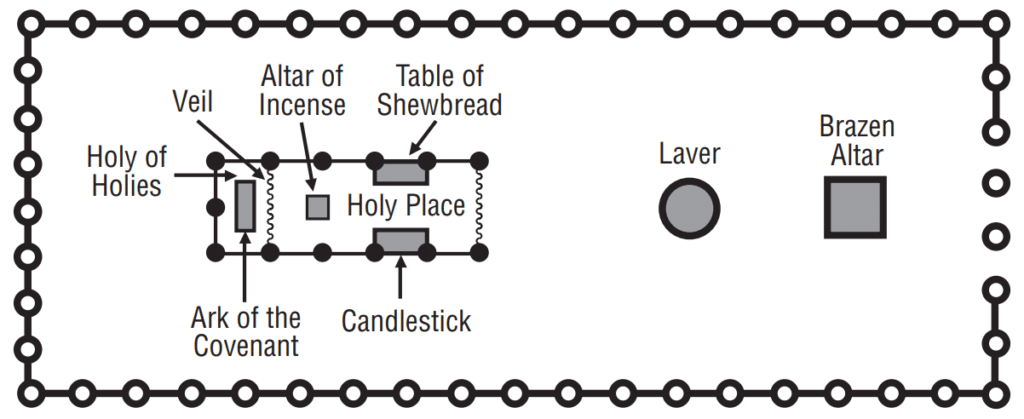LESSON EIGHT
The Tabernacle
The Tabernacle and its furnishings have many lessons for us. Examine the diagram closely. Notice the three sections: the large area of service, the Holy Place, and the Holy of Holies. Each area was hidden from the others by curtains. When Solomon built his temple after the Israelites had settled in the Promised Land, he followed the same pattern for the inner parts, carefully following God’s instructions.

Note the pieces of furniture. The first is the Brazen Altar, which was used for sacrifice and atonement.
Then came the Laver. It was used for cleansing.
Proceeding into the Holy Place, on the right is the Table of Shewbread; on the left is the Candlestick. Straight ahead is the Altar of Incense.
Beyond this Altar is the Veil of the Tabernacle that hid the Holy of Holies from the eyes of everyone except the High Priest. In the Holy of Holies we find the Ark, which was the earthly dwelling place of God.
As you study this lesson, you will see how God prepared this Tabernacle, not just for worship and sacrifice, but also as an illustration of the Son he would send to earth.
Lesson Objective: To understand how the Tabernacle pictures the work of Christ
BIBLE STUDY
Read Exodus 25–27
Before you consider the many verses below, be sure to read the Bible passage listed above.
If you click on the verses in the study below you can see the entire verse! If you are not on-the-go, consider opening a physical Bible and looking up the passages.
The Furnishings
Read Exodus 25–27.
- The Brazen Altar
Read Exodus 29:36, 37 and describe how the Altar was used.
Why do you think the Altar was placed just inside the entrance?
Read Hebrews 13:10–16. How does the Brazen Altar reflect Christ’s sacrifice?
What sacrifices are we to offer? - The Laver
Read Exodus 30:18–21 and describe the Laver and its use.
What is the parallel in Ephesians 5:25–27?
What is our part (1 John 1:9)?
The cleansing is not the forgiveness we receive when we become Christians. It is what we do after we are children of God to be cleansed of our sins.
How does what the priests did at the Laver help us know that?
Why is the Laver placed between the Altar and the Holy Place? - Table of Shewbread
Read Exodus 25:23–30 and Leviticus 24:5–9. Describe the Table and how it was used.
How is the Shewbread a picture of Christ (John 6:32–35, 50, 51)?
As Christians, God considers us priests (Revelation 1:6).
When we partake of the Lord’s Supper, what should our attitude be toward the bread (1 Corinthians 11:23, 24)? - The Candlestick
Read Exodus 25:31–40; 27:20, 21. Describe the Candlestick and how it was used.
How is this a picture of Jesus (John 8:12)?
How does this relate to our daily lives (John 12:35, 36)? - Altar of Incense
Read Exodus 30:1–8. Describe the Altar of Incense and its use.
The Altar of Incense is the reminder of our prayers, which are an incense to God. According to Revelation 8:3, 4, what happens to our prayers?
What kind of attitude should we have toward prayer (Psalm 141:2)?
Why do you think the Table of Shewbread, Candlestick, and Altar of Incense were placed inside the Holy Place? - Ark of the Covenant
The Holy of Holies was hidden by a veil. Inside we find the Ark, which was the dwelling place of God himself. What was placed inside the Ark (Hebrews 9:4)?
What was on it (verse 5)?
Who was the only person allowed to enter the Holy of Holies (verses 6, 7)?
Why was the Ark separate from the other furnishings?
Why was it placed in the Holy of Holies?
Christ as High Priest
- How was the Tabernacle set up and sanctified (Exodus 40)?
What significance did the cloud have? - What part did Aaron play?
- What happened to the veil at Christ’s death (Matthew 27:50, 51)?
What did this signify? - Describe why Christ is the final High Priest (Hebrews 9:6–14).
- Compare the old covenant with the new (Hebrews 9:15–23).
- Christ is both the sacrifice and the High Priest. Read Hebrews 9:24–28. Describe how this is so.
What is the hope this gives us?
LIFE APPLICATION
Questions
- What has Christ done for us as recorded in Hebrews 10:10?
- How should we live accordingly (Hebrews 10:19–25)?
- What have you learned from the Tabernacle that will help you live your daily life?
- We must remember to keep the proper spiritual sequence in our Christian lives as we live victoriously for Christ. What has the Tabernacle taught you about this sequence?
How will you use this knowledge to live victoriously? - Do you understand how the Tabernacle pictures the work of Christ?
Memory Verse: “For God’s will was for us to be made holy by the sacrifice of the body of Jesus Christ, once for all time.” (Hebrews 10:10 NLT)